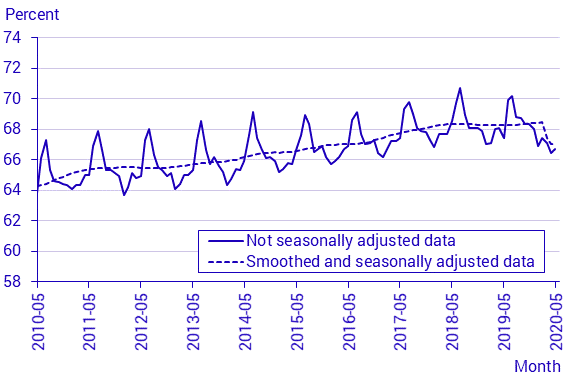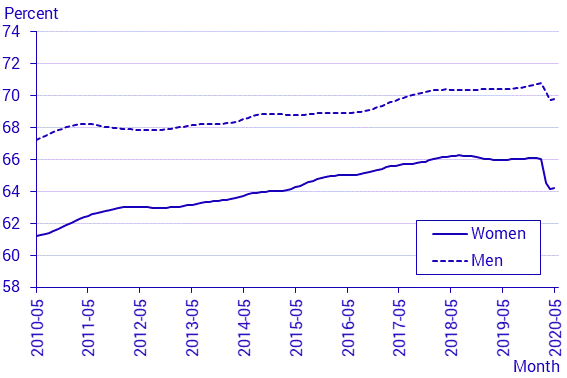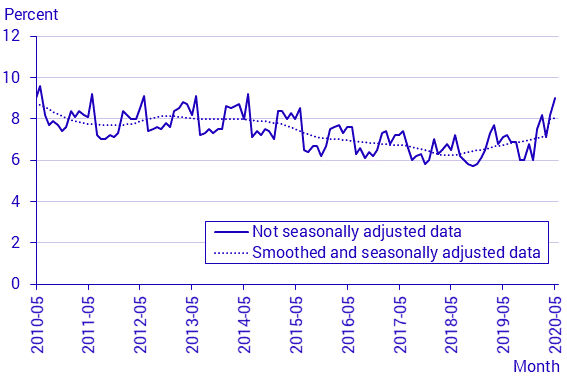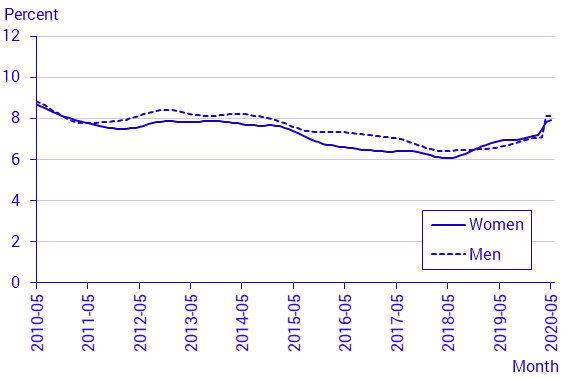Labour Force Surveys (LFS), May 2020
Unemployment continues to increase
Statistical news from Statistics Sweden 2020-06-17 9.30
In May 2020, there were 5 023 000 employed persons. The number of unemployed persons increased by 110 000 to 497 000. This corresponds to an unemployment rate of 9.0 percent, an increase by 1.9 percentage points. The average number of hours worked amounted to 147.4 million hours per week, which corresponds to a decrease of 7.7 percent, calendar-adjusted. Seasonally adjusted and smoothed data shows a decrease in employment and an increase in unemployment. The unemployment rate was 8.0 percent.
The change estimate concerning the number of persons in the labour force between May 2019 and May 2020 may be somewhat overestimated. This may be due, in part, to the fact that the number of employed persons, and thereby the number of persons in the labour force, appears to have been somewhat underestimated in May 2019.
Labour force
In May 2020, there were 5 520 000 persons aged 15–74 in the labour force, not seasonally adjusted, which is an increase of 76 000 persons compared with May 2019. The number of men in the labour force increased by 56 000 to 2 909 000 and the number of women was 2 611 000. The labour force participation rate among persons aged 15─74 was 73.3 percent. Among men, the labour force participation rate was 75.9 percent, and among women it was 70.6 percent.
Seasonally adjusted and smoothed data shows that there were 5 493 000 persons in the labour force. This is 58 000 persons fewer than in February 2020, when the effects of the coronavirus (COVID-19) outbreak were not yet discernible in the Swedish labour market. The labour force participation rate was 72.9 percent, a decrease of 0.8 percentage points compared with February 2020.
Employment
In May 2020, there were 5 023 000 employed persons aged 15─74, not seasonally adjusted. There were 2 660 000 employed men and 2 363 000 employed women. The employment rate was 66.7 percent. Among men, the employment rate was 69.4 percent and among women it was 63.9 percent.
Seasonally adjusted and smoothed data shows that there were 5 052 000 employed persons, which is 104 000 fewer than in February 2020. The employment rate was 67.0 percent, a decrease of 1.4 percentage points compared with February 2020.
Employees
In May 2020, there were 4 547 000 employees, not seasonally adjusted. Among men, there were 2 316 000 employees, and among women the number of employees amounted to 2 231 000. There were 3 862 000 permanent employees aged 15-74 in May 2020. Among men, the number of permanent employees was 1 999 000 and among women it was 1 863 000.
There were 685 000 temporary employees. There were 317 000 temporary employed men, and the number of temporary employed women decreased by 52 000 to 368 000.
Compared with February 2020, smoothed and seasonally adjusted data shows a decrease in both the number of permanent employees and the number of temporary employees.
Hours worked
On average, the number of hours worked in May 2020 amounted to 147.4 million per week, not seasonally adjusted, a decrease of 7.7 percent in calendar adjusted figures compared with May 2019. The largest decrease was in Hotels and restaurants, where the number of hours worked, calendar adjusted, decreased by 47.9 percent compared with May 2019. Manufacturing of machinery and transport equipment decreased by 20.0 percent and Trade decreased by 10.9 percent. A decrease was also noted in Education.
Seasonally adjusted and smoothed data shows a sharp drop in the number of hours worked compared with adjacent months, on average amounting to 141.3 million hours per week, which is 13.8 million hours less per week than in February 2020.
In work and absence
There were 4 538 000 persons employed and in work in May 2020, which is 146 000 fewer than in the same month a year ago. This decrease can mainly be explained by an increase in the number of persons absent for the whole week.
The LFS estimates the number of persons who were absent for the whole week or for part of the week from their principal occupation by main reason for absence. There were 491 000 persons absent for the whole week, which is 106 000 more than in May 2019. Among these, 164 000 were absent due to illness, which is an increase of 66 000. The number of persons absent for the whole week due to lack of work increased to 40 000, and the number of persons absent due to lay-offs increased to 37 000. On the other hand, the number of persons who were absent due to holidays decreased to 34 000, which is a decrease of 48 000 compared with the same month a year ago.
Among persons who are absent due to lack of work or lay-offs, it is common that the absence is only for a part of the week. The total number of persons absent for the whole week or part of the week due to lay-offs increased to 270 000. The corresponding figure for persons who stated lack of work as the main reason for their absence was 109 000, an increase of 85 000 persons.
Seasonally adjusted and smoothed data shows that there were 4 096 000 persons in work, which is 271 000 fewer than in February 2020. There were 957 000 persons absent for the whole week, which is 167 000 more than in February.
Unemployment
In May 2020, there were 497 000 unemployed persons aged 15─74, 110 000 more than in the same month a year ago. This corresponds to an unemployment rate of 9.0 percent, an increase of 1.9 percentage points. The number of unemployed men increased by 49 000 to 249 000 and among women it increased by 61 000 to 248 000. Among men the unemployment rate increased by 1.6 percentage points to 8.6 percent and among women it increased by 2.3 percentage points to 9.5 percent.
Among young persons aged 15─24, there were 177 000 unemployed persons. This corresponds to an unemployment rate of 29.8 percent, an increase of 6.1 percentage points compared with the same month a year ago. Among unemployed young people, 140 000 persons were full-time students, which is an increase of 33 000.
Among persons aged 15–74, smoothed and seasonally adjusted data shows an increase of 46 000 in the number of unemployed persons and an increase of 0.9 percentage points in the unemployment rate compared with February 2020. There were 441 000 unemployed persons in May 2020, which corresponds to an unemployment rate of 8.0 percent.
Among young persons aged 15─24, smoothed and seasonally adjusted data shows an increase in both the number of unemployed persons and in the unemployment rate compared with February 2020. The number of unemployed young persons increased by 25 000 to 150 000 and the unemployment rate increased by 5.0 percentage points to 24.9 percent.
Impact of COVID-19 on the labour market
In view of the ongoing coronavirus (COVID-19) pandemic, additional questions concerning the impact of COVID-19 have been added to the LFS. Based on these questions, 177 000 employed persons aged 15–74 years stated that they were absent during the whole reference week in May, related to COVID-19. This means that among persons who were absent during the entire reference week, 36.4 percent were absent due to COVID-19. The proportion among men was 40.6 percent and 33.2 percent among women.
Among employees aged 15–74 years who were absent during the entire reference week, 35.1 percent, which corresponds to 158 000 persons, stated that their absence was linked to COVID-19. The proportion was 39.5 percent among men and 32.2 percent among women. Furthermore, among employees who were absent during part of the reference week, 21.7 percent, corresponding to 402 000 persons, stated that their absence was linked to COVID-19. Among self-employed persons and assisting household members aged 15–74 years, 45.4 percent felt that they had less work due to the coronavirus pandemic, while 15.9 percent felt that they had more work.
Among persons who were not employed and who have left their employment since March, 96 000 stated that this was as a consequence of the pandemic.
To be classified as unemployed in the LFS, a person must be without a job, must be able to start work and must have sought work. This means that people who are without a job, but who have not been seeking work or are not available to start work are not defined as unemployed, but are defined, instead, as not in the labour force. In May 2020, 2 015 000 persons aged 15–74 years were not in the labour force. Among these people, 73 000 persons stated that they would have been able to start work, but had not been seeking work due to COVID-19. In addition, 42 000 persons stated that they would have been unable to start work due to COVID-19.




Next publishing will be
2020-07-23 at 9:30.
Feel free to use the facts from this statistical news but remember to state Source: Statistics Sweden.
